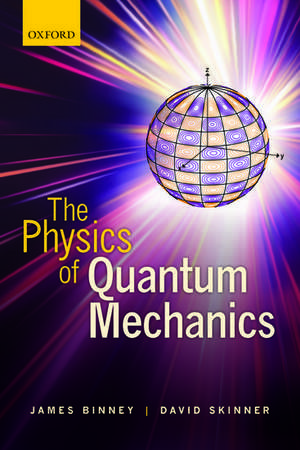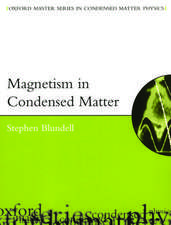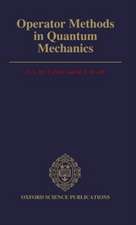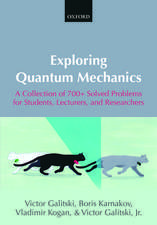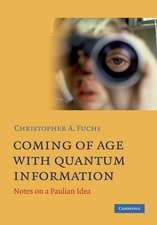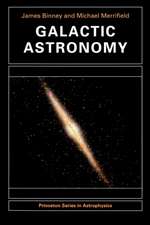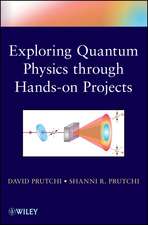The Physics of Quantum Mechanics
Autor James Binney, David Skinneren Limba Engleză Paperback – 31 oct 2013
| Toate formatele și edițiile | Preț | Express |
|---|---|---|
| Paperback (1) | 264.39 lei 31-38 zile | |
| Oxford University Press – 31 oct 2013 | 264.39 lei 31-38 zile | |
| Hardback (1) | 544.48 lei 31-38 zile | |
| OUP OXFORD – 31 oct 2013 | 544.48 lei 31-38 zile |
Preț: 264.39 lei
Nou
Puncte Express: 397
Preț estimativ în valută:
50.59€ • 54.10$ • 42.18£
50.59€ • 54.10$ • 42.18£
Carte tipărită la comandă
Livrare economică 07-14 aprilie
Preluare comenzi: 021 569.72.76
Specificații
ISBN-13: 9780199688579
ISBN-10: 0199688575
Pagini: 416
Ilustrații: 75 b/w illustrations
Dimensiuni: 156 x 234 x 23 mm
Greutate: 0.62 kg
Editura: Oxford University Press
Colecția OUP Oxford
Locul publicării:Oxford, United Kingdom
ISBN-10: 0199688575
Pagini: 416
Ilustrații: 75 b/w illustrations
Dimensiuni: 156 x 234 x 23 mm
Greutate: 0.62 kg
Editura: Oxford University Press
Colecția OUP Oxford
Locul publicării:Oxford, United Kingdom
Recenzii
This book is a deep, well-explained and beautiful text on the foundations and applications of quantum mechanics. It is eminently suitable for advanced undergraduates and graduates who wish to study the subject. Some precious jewels can be found within after building up the Dirac representation of quantum mechanics: scattering theory and condensed matter applications, for example.
The extensive discussion of the physics behind the mathematical manipulations of the theory, coupled with the smooth, colloquial writing style and delightful historical footnotes makes this book somewhat unique in the field. It devotes large sections to the more modern topics of quantum computing and quantum measurement theory, which are active areas of current research. In addition, there is a copious selection of problems, at all levels of difficulty, which should prove extremely useful to anyone teaching the course.
Binney and Skinners introductory book on quantum mechanics approaches the subject in a unique way ... The text is very well written for the target audience of second or third year University students in Physics, Chemistry, or certain Engineering specialties and I would highly recommend it for anyone who might be considering teaching or tutoring such a course.
The extensive discussion of the physics behind the mathematical manipulations of the theory, coupled with the smooth, colloquial writing style and delightful historical footnotes makes this book somewhat unique in the field. It devotes large sections to the more modern topics of quantum computing and quantum measurement theory, which are active areas of current research. In addition, there is a copious selection of problems, at all levels of difficulty, which should prove extremely useful to anyone teaching the course.
Binney and Skinners introductory book on quantum mechanics approaches the subject in a unique way ... The text is very well written for the target audience of second or third year University students in Physics, Chemistry, or certain Engineering specialties and I would highly recommend it for anyone who might be considering teaching or tutoring such a course.
Notă biografică
James Binney has degrees from the universities of Cambridge and Oxford and has studied in the Albert LudwigsUniversitaet, Freiburg i. Breisgau. After three postdoctoral years in Princeton he joined the Physics faculty atOxford and has there taught courses ranging from first-year mathematical methods, through statistical physics,quantum mechanics, general relativity, group theory and differential geometry and physics. He researches thestructure, formation and dynamics of galaxies. For this work he has received the Maxwell Medal and the DiracMedal from the Institute of Physics, the Dirk Brouwer Award from the American Astronomical Society and theEddington Medal from the Royal Astronomical Society. He was elected a Fellow of the Royal Society in 2000. He isjoint author of Galactic Dynamics (Princeton UP 1987, 2008), Galactic Astronomy (Princeton UP 1998) and TheTheory of Critical Phenomena (Oxford UP 1992).David Skinner obtained his PhD from Oxford Physics and took postdoctoral positions in Oxford Maths, Perimeterand IAS before joining DAMTP, Cambridge. He is interested in quantum field theory, string theory and twistortheory.
